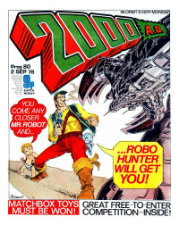
Forty years ago, in February 1977, a green-skinned alien from Betelgeuse who absolutely, quite categorically was not editor Kelvin Gosnell in a joke shop mask hurled Britain’s comics readers into the far, far future world of 2000 AD, and somehow, in 2017, we’re still there!
Springing from the fertile mind of Pat Mills, the man who had delighted kids and outraged parents with the UK weekly Action just the previous year, the self-styled ‘Galaxy’s Greatest Comic’ introduced the bewildered kids of mid ‘70s Britain to a universe of limitless possibilities from futuristic football players to time-travelling cowboys trapping dinosaurs for their flesh to feed a starving world. But it’s unlikely that anyone involved back then really foresaw the impact of the phenomenon they were creating – or that this new title would still be going strong when the year 2000 itself was fast becoming a distant memory!
 Originally created by Mills and John Wagner at the suggestion of Gosnell (alter ego of the Mighty Tharg), 2000 AD was an attempt to cash in on the then imminent craze for SF which Gosnell knew would be generated by the wave of forthcoming science fiction movies (including the original Star Wars). As such, it was never really envisaged as being a long-term success, crazes tending to come and go, but 2000 AD’s creators had faith in it, and a great deal more commitment than the old hands behind a lot of publisher Fleetway’s other titles at the time. Most of whom did not really see the potential of comics in quite the same way…
Originally created by Mills and John Wagner at the suggestion of Gosnell (alter ego of the Mighty Tharg), 2000 AD was an attempt to cash in on the then imminent craze for SF which Gosnell knew would be generated by the wave of forthcoming science fiction movies (including the original Star Wars). As such, it was never really envisaged as being a long-term success, crazes tending to come and go, but 2000 AD’s creators had faith in it, and a great deal more commitment than the old hands behind a lot of publisher Fleetway’s other titles at the time. Most of whom did not really see the potential of comics in quite the same way…
To begin with, 2000 AD was not that different to a lot of the titles that had preceded it, the most notable strips in issue one being M.A.C.H. 1 (essentially a rip-off of the then popular TV character The Six Million Dollar Man, though agent John Probe probably came rather cheaper since he basically got his superhuman powers from a form of acupuncture involving electrified needles!) and Dan Dare, a reinvention of the 1950s hero of the legendary Eagle comic, now inexplicably updated from a spacefaring Biggles to a sci-fi version of Dirty Harry.
The rest of the issue was filled out by future sports stars the Harlem Heroes and by Invasion 1999, which told the story of Bill Savage’s lone fight to free Britain from the ‘Volgan’ invaders who absolutely, definitely were not the Russians, despite the Volga being a river in Russia. But then, in Prog #2 (‘Prog’ standing for ‘Programme’, which sounded more futuristic than ‘issue’) a new character appeared – the fascist future cop Judge Dredd – and British comics would never be the same again!
It took a few months for Dredd, an emotionless law enforcer in a nightmarish Mega City of the future, to really get into his stride but when he did, he quickly became one of 2000 AD’s most popular characters. The attraction for readers was less to do with Dredd himself (who often seemed more like a robot than a man and was never seen without his face-obscuring helmet – two things which seemed to render him something of a blank slate in terms of personality) than it was the world he inhabited. Mega City One was a city of several hundred million people taking up much of what had, prior to a nuclear war which devastated much of the world, been the Eastern seaboard of the United States.
The city was a crazy place, where criminals serving life sentences were imprisoned on a giant traffic island surrounded by cars constantly moving at a hundred miles an hour so that guards were not needed. It was also a locale where the Mayor was an orang-utan called Dave, and where citizens indulged in a seemingly endless variety of weird crazes in order to stave off the boredom of a lifetime spent in a city with 90% unemployment.
Keeping a lid on the constantly building pressure in the Mega City were the Judges, trained from the age of five (or in the case of Dredd, a clone, from birth) to care for nothing but a law in which the smallest infraction was dealt with mercilessly. The strip was part action adventure, part satire on our own world taken to extremes, and the readers loved it.
As time went on, some of the original line-up fell by the wayside (notably Dan Dare, a character nobody really knew what to do with in this brave new world, having gone from Clint Eastwood clone with a crew of ex-cons to a costumed superhero-type facing down the evil Mekon armed with Eternicus, the Cosmic Claw). They were replaced by others who, by accident or design, would capture the readers’ imaginations in a big way.
John Wagner, Alan Grant and Ian Gibson’s Sam Slade, Robo-Hunter, a wisecracking and rather cynical private eye, quipped his way through a series of anarchic adventures with insane mechanoids armed only with his wits and a large blaster gun and aided by a colourful supporting cast. These included Hoagy a dim-witted robot built from a kit, a talking robotic Cuban cigar and an embittered space pilot named Jim Kidd who was trapped in the body of a one-year-old.
M.A.C.H. 1 died, but was replaced by his monstrous predecessor, the failed experiment M.A.C.H. Zero, and we were introduced to bizarre new creations such as The Visible Man, whose skin and flesh were made transparent by a freak accident (in fact, this last strip was originally intended to be a part of the opening line-up, but was held back for some months).
The premature demise of sister comic Starlord which was merged into 2000 AD in 1978 brought mutant bounty hunter Johnny Alpha, AKA the Strontium Dog into the fold. Also joining from Starlord were the lunatic members of the disaster squad named Ro-Busters, notably the ill-matched pairing of sewer robot Ro-Jaws and ex-war droid Hammerstein, forebears of the fan favourite ABC Warriors.
The equally swift cancellation of Tornado weekly in 1979 similarly yielded telepathic teen Wolfie Smith in The Mind of Wolfie Smith and displaced Roman Centurion Black Hawk, now fighting in an alien arena. And as 2000 AD moved into the Eighties we were introduced to a whole host of new stars in the comics firmament; the long-running future war strip Rogue Trooper, Celtic warrior Slaine, Grant Morrison’s Zenith and many others.
 The Eighties were a Golden Age for 2000 AD, but more than that they were something of a new Golden Age for the comics industry in part because of 2000AD. The creators behind strips such as Slaine, Nemesis, Halo Jones and Skizz – individuals like Alan Moore, Bryan Talbot, Brian Bolland, Dave Gibbons, Alan Davis and Kevin O’Neill – would come to the attention of the big American publishers because of their work on the comic (and to a slightly lesser extent, in the case of Moore and Davis, their work for Warrior magazine and Marvel UK).
The Eighties were a Golden Age for 2000 AD, but more than that they were something of a new Golden Age for the comics industry in part because of 2000AD. The creators behind strips such as Slaine, Nemesis, Halo Jones and Skizz – individuals like Alan Moore, Bryan Talbot, Brian Bolland, Dave Gibbons, Alan Davis and Kevin O’Neill – would come to the attention of the big American publishers because of their work on the comic (and to a slightly lesser extent, in the case of Moore and Davis, their work for Warrior magazine and Marvel UK).
Many of those creators were duly head-hunted by Marvel or DC, reinvigorating the by then moribund US comics industry, while 2000 AD sought out a new wave of talent to replace them – people like Garth Ennis and Grant Morrison – who were in turn snapped up by the big boys in the late Eighties and early Nineties. The cycle continued.
As 2000 AD moved into the Nineties, its fortunes rose and dipped several times. Spin-off publications abounded, like the long running Judge Dredd Megazine and Pat Mills’ shorter-lived but often groundbreaking Crisis. But revamps of the formerly popular Rogue Trooper, Harlem Heroes and Robo-Hunter did not do as well as the original versions, and the killing off of Johnny Alpha (a decision which so upset long-time Strontium Dog artist Carlos Ezquerra that he refused to draw it) also proved a mistake.
A big budget Judge Dredd movie starring Sylvester Stallone turned out to be something of a misfire in 1995, and in addition, 2000 AD’s publisher, Fleetway, went through changes of ownership, first becoming a part of Robert Maxwell’s media empire, then a part of London Editions, before eventually being sold off (in 2000, appropriately enough) to games developer Rebellion, under whose stewardship it has recovered from the mistakes of the Nineties and become a force to be reckoned with once more.
Old troupers like Dredd, shotgun-toting revolutionary Bill Savage and a revived Johnny Alpha sit alongside newer stars such as Russian rogue Nikolai Dante, the hapless hit-men Sinister Dexter, the stars of The Order, Kingdom and too many others to mention.
Recently, the stars of 2000 AD have even been having another crack at the American market, with both new, US produced Judge Dredd stories from IDW and US format reprints of series such as INJ Culbard and Ian Edginton’s Brass Sun. There was a second Dredd movie too, in 2012, and while it still didn’t set the world on fire, it was at least a critical success.
Seventeen years after the far future it was named for finally arrived (an era which sadly proved devoid of the personal jet packs and flying cars we’d all been promised by many a mid -Seventies edition of the TV show Tomorrow’s World), 2000 AD is still firmly established as one of the mainstays of the admittedly sadly diminished British comics industry. If not quite as popular now as it’s ever been (what comics are?) then at least more than holding its own.
Much of the title’s back catalogue of strips is finding its way back into print in some truly beautiful collected editions, there are computer games and limited edition action figures, and the Judge Dredd Megazine has just passed its 375th issue. A notable achievement in itself these days. But perhaps more importantly, 2000 AD continues to find the best and brightest new British comics talents, doing its bit to prop up our beloved comics industry as few other titles can or ever have done.
Roll on the next forty years!
For more on 2000 AD visit the official website here and their online store here. You can also follow the Galaxy’s Greatest Comic on Twitter here.


























